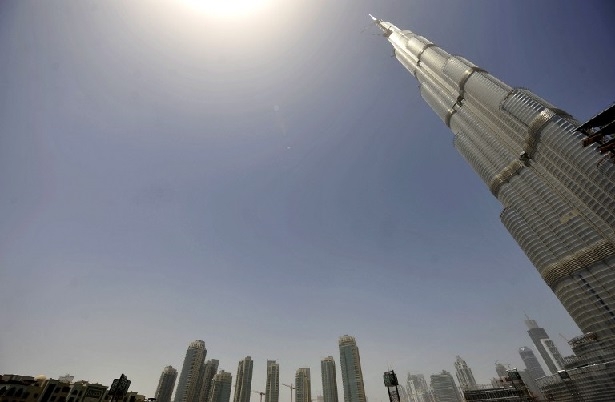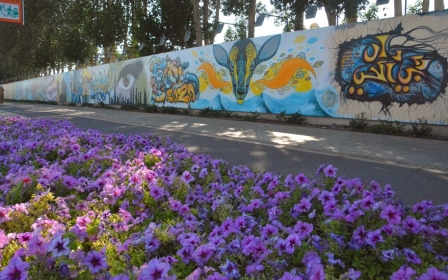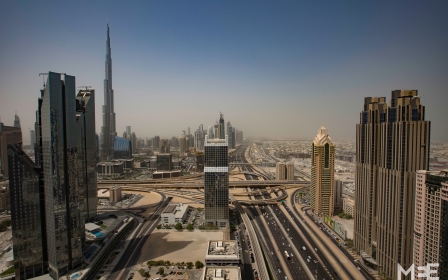City in the sky: Dubai’s constructed identity set to get even taller

If Dubai’s walls could talk, they may say something like "You think this is big? Just watch this place."
That's certainly the message once again ringing out from developers and investors who hail from the emirate and beyond and appear determined to make Dubai's already notorious skyline even more dramatic.
In the heady pre-recession boom, Dubai grew famous for its archetectural boldness and grand ambitions to reach for the skies as skyscraper after skyscraper was erected.
As the finanicial crisis began to bite, however, many of these grand schemes fell by the wayside as the country's property bubble - driven by rampant and unregulated flipping of off-plan units and houses bought on credit - burst dramatically. The situation was dire with stories of expats jumping on planes overnight rampant but following a $10bn bailout from neighbouring Abu Dhabi in 2009, Dubai managed to bounce back.
In 2010, the city became home to world’s tallest building, the 828-metre Burj Khalifa which was renamed from the Burj Dubai after the bailout sanctioned by the the ruler of Abu Dhabi, Khalifa bin Zayed.
The building stands as a visible testament to Dubai’s survival and continued success after potential ruin, although the turbulence did usher in a new age defined by more regulation and a conservative market that analysts say is in the downward period of its second cycle.
But Dubai's ambitions have not been dampened and plans are now underway to build the world’s tallest commercial tower, tallest residential tower and tallest twin towers – which are all part of the government programme of constructed identity through iconic buildings.
This desire for this kind of construction is deeply engrained in Dubai.
Dubai’s legacy is said to have begun under Sheikh Rashid bin Saeed al-Maktoum who was instrumental in erecting the city’s World Trade Centre completed in 1978 , but it took off under his son Sheikh Mohammed bin Rashid bin al-Maktoum, with the construction of the one-time world’s tallest hotel, the Burj al-Arab, which opened in 1999.
Thirty-one-year-old Faisal Durrani, head of research for the property consultancy Cluttons, lives in London but spent the first 25 years of his life in Dubai. He wasn’t born when the trade centre opened but he understands its importance.
“Sheikh Rashid decided he was going to put an iconic building on [what was then] the outskirts of the city that he hoped would attract the attention of the international investor community – and it did. In a way it jumpstarted development in that part of the city and then it spread along Sheikh Zayed Road,” Durrani says, explaining how the development then fanned out along the city’s major six-lane arterial route.
Diversify or die
For a city with limited oil reserves, Dubai has had to be bold. Necessity is the mother of invention, and Dubai’s rulers cottoned on to a central tenet that has seen it flourish: diversify or die. More than 70 percent of the GDP is now comprised of non-oil sectors, such as aviation, tourism and property.
This point is not lost across the region, where many flock to Dubai as a property Mecca. The tumbling price of oil has underscored the importance of having a broad economy, Durrani says.
“Other locations in the region are also conscious of the attention that tall buildings bring, but … the appetite for those markets is probably quite different and has to be considered.”
Dubai now has “first mover” advantage, Durrani says, and its reputation has travelled far.
“I think the skyline of the city in the 21st century is something quite important and the fact that Dubai is only about 40 years old and it has a skyline that rivals Manhattan and Shanghai is quite impressive. It’s spoken about in the same breath and it gives the impression of being a mega global city - which it is.”
The director at energy and sustainability firm AESG, Scott Coombes, who also grew up in Dubai, says this reputation has been important in attracting tourism and also inspiring confidence in the financial sector.
“Dubai has been trying to establish itself as this financial hub of the Middle East for the last two decades or so and part of that is they have to portray this image of global stance and strength [as in] other financial global hubs. Singapore, New York, London - they all portray this image of built-up cities.”
Government or partially government-owned companies are responsible for much of the development, meaning there has been a large degree of control in the urban planning. But geology has also had an unusual role, Coombes explains.
Dubai has a large quotient of stable bedrock that makes it ideal for building upwards.
“Here we’re in a desert and have this unlimited field of land that we can build on and sprawl out on, yet we see condensed pockets [that] create these central business zones that people can work around.”
The bedrock issues alongside the relative lack of red tape in the sheikhdom means building skywards can be done quickly and affordably.
Race to a mile high
With Jeddah’s Kingdom Tower tipped to come in over a kilometre high, it may seem skyscrapers are reaching the outer limits of what is humanly possible. But not so, says Coombes, who thinks we may be on the verge of a race to the top to break the mile limit.
“I think technically and structurally skyscrapers of two kilometres are entirely feasible.”
Feasible – but not commercially viable. The core of the building, where the lift shafts run, would have to be large enough to fit lifts to accommodate those working inside. That would diminish available floor space, Coombes says.
Skyscrapers also often have a “vanity height," usually about 10 percent of unusable space – spikes and spires and the like – that propels buildings into the record books. Commercial towers are built with little vanity height and very close together because finances, not statements, are being considered.
Because of this, Coombes expects any race to the mile to happen in the GCC or Asia. The buildings need to be funded by backers not overly concerned about the financial return, and more motivated by city image.
“It’s just a case of who has the justification to fund and finance these sorts of buildings. They are breaking boundaries as to what’s structurally capable of these materials and what’s safe and what’s efficient.”
A bold vision
Dubai has taken criticism for many things: its human rights record and excessive materialism to name two. However, no one can deny its success, largely tied up in its construction sector.
Back to Durrani, who thinks Dubai has already got one of the top-three skylines in the world.
“Skyscrapers inspire a sense of confidence," he says. "We’ve had a project like [record-breaking] Meydan One and that’s at a time when … some residential values are declining due to various reasons - yet you’re seeing the government continue to push ahead with its vision for Dubai and the UAE.”
One such envelope-pushing skyscraper under construction is the 46-storey Royal Atlantis tower, an extension to the existing Atlantis hotel on the exclusive man-made Palm Island.
Ian Connolly is the chief development officer for Royal Atlantis developers Kerzner International.
The $1.4bn residential and hotel project has been fully financed, though homes in the building will go on sale later. Connolly said the company has seen “significant interest” from both the local and international markets in these homes.
“Dubai is now on par with any global city – whether that be New York, London or Hong Kong. The infrastructure is strong and people are building lives here, it is not just a holiday destination.”
The Royal Atlantis building is innovative by even Dubai standards and Connolly says the government has encouraged imagination.
“The vision of Dubai is incredible … not only did they want bold buildings, but they invested in the infrastructure and the destination as a whole - this is astounding. Dubai is on par with the global cities of the world, but with a better infrastructure.”
The expat Brit, who has lived in Dubai for the past decade, says he is not worried about the recent general suppression in Dubai’s property market that saw residential sales drop 20 percent in the first eight months of the year.
“Every mature city has a property market which fluctuates. Some areas, some properties outperform others. We now see Dubai entering this mature stage as certain areas and products maintain their market value or even show an increase.”
Dubai’s top five to watch
Royal Atlantis Resorts and Residences – An extension of existing mega-hotel and waterpark Atlantis, on Palm Island.
The 46-storey tower, which looks a bit like a game of Jenga, features an 800-room hotel, 250 luxury residences and retail spaces, and a pool 90 metres above the ground.
Chief development officer for Royal Atlantis developers Kerzner International Ian Connolly says the development is working with a range of artists to ensure each residence is bespoke, in a Dubai first, and it will also showcase a fire and water feature “in a way that has never been seen before”.
Entisar Tower – This proposed 520-metre tower, to be undertaken by major Dubai developer Meydan Group, will nestle in around other big towers, like the Nassimi Towers, at the start of Dubai’s business district.
Fronting Sheikh Zayed Road, the $350mn tower is anticipated to have 444 apartments, including serviced apartments, sky villas, and a 112-room hotel. There are also plans for a 250-metre indoor running track, two tennis courts and nine swimming pools when work gets underway any day now.
Durrani says: “The location is quite unique being in the centre of Dubai and given that it’s going to be probably the third-tallest building in the city [for a while] I think it’s going to be quite iconic from that respect.”
Burj 2020 – This tower, proposed by and being built to house the Dubai Multi Commodities Centre, is anticipated to stretch over 700 metres though it is yet to be confirmed.
The top two floors of what is slated to become the world’s tallest commercial tower is also expected to have one of the world’s highest observation decks with a 360-degree view.
The building is being built in "new Dubai" in the city’s Jumeirah Lakes Tower district, and will be surrounded by six smaller buildings. The iconic structure will take root near residential communities, but offer space to cope with “pent up demand” in the city’s prime free zone, Durrani says.
One of the problems that the Grade A office market faces in Dubai is a lack of efficient space and large floor plates.
DMCC set out to address this issue and provide space that will be leased back into the market.
Architects Adrian Smith and Gordon Gill are charged with building Saudi Arabia’s Kingdom Tower, which will be the tallest tower in the world upon construction. They also worked on the Burj Khalifa with a different practice.
Dubai One Tower – This tower is another Meydan structure, and will be the tallest residential building in the world. It is part of the astronomical $6.8bn Meydan One community, which is also to be home to the world’s longest indoor ski slope, the world’s tallest dancing fountains and a shopping centre with a retractable roof.
At 711 metres, the building will make way for 885 apartments and a five-star hotel with 350 rooms. It is also due to have the world’s highest observation deck (655 metres) and the world’s highest restaurant (675 metres) – higher than those in the world’s current tallest building, the Burj Khalifa.
Development is due to start by 2020.
RP One – This $1.1bn project, by Indian developers RP Global is to feature another one of the world’s tallest towers. Situated in the adjacent district to where the Burj Khalifa sits, in Business Bay, the skyscraper at the heart of the project is anticipated to be over 400 metres tall, according to Faisal Durrani.
While few details exist yet about what RP One will hold aside from a hotel and apartment complement, Durrani says this building will make waves as it will be the first supertall tower (300+ metres) neighbouring the Burj Khalifa.
“Around the Burj Khalifa, they’ve kept everything quite low, around 30 storeys, which allows you to appreciate the tower - but you haven’t got anything of a comparable height to appreciate how tall it is.”
The building will be about half the height of the Burj Khalifa, which will “be a nice little comparison”.
“It won’t detract from the Burj Khalifa, it will complement it I think.”
Middle East Eye propose une couverture et une analyse indépendantes et incomparables du Moyen-Orient, de l’Afrique du Nord et d’autres régions du monde. Pour en savoir plus sur la reprise de ce contenu et les frais qui s’appliquent, veuillez remplir ce formulaire [en anglais]. Pour en savoir plus sur MEE, cliquez ici [en anglais].




